 As a professional wedding officiant, I’ve been specializing in multicultural and interfaith wedding ceremonies for over a decade. Often, when I first speak to a couple whose families are from different religious or cultural backgrounds, they are very concerned with creating a ceremony that honors both of their families’ heritage and traditions without offending or excluding their partner, family, or guests.
As a professional wedding officiant, I’ve been specializing in multicultural and interfaith wedding ceremonies for over a decade. Often, when I first speak to a couple whose families are from different religious or cultural backgrounds, they are very concerned with creating a ceremony that honors both of their families’ heritage and traditions without offending or excluding their partner, family, or guests.
It can be a challenge to navigate the appropriate blending of different traditions, especially when religion is involved. It is important that you choose a wedding officiant who is educated, informed, and sensitive to the different needs of each cultural or religious background that you may want to include. There is a big difference between a ceremony that has a a few “religious or cultural elements” thrown together haphazardly, and a ceremony that is custom-designed with the history and depth of those traditions in mind.
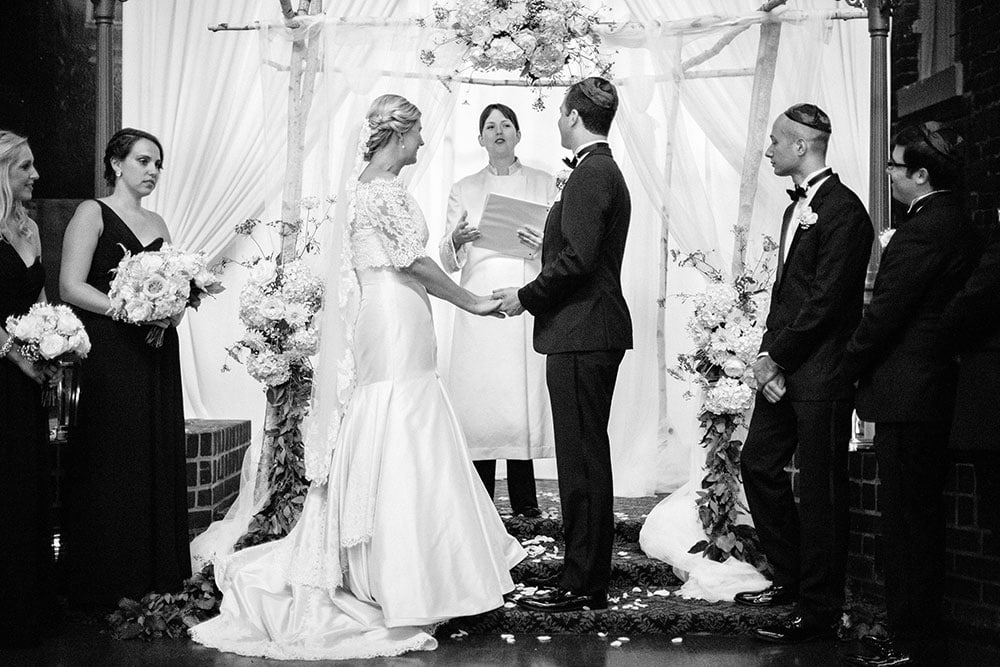
When I create interfaith and/or multicultural wedding ceremonies, my focus is primarily on inclusion – I seek to ensure that each party feels represented in the ceremony in a way that is meaningful to them. Every ceremony I write is custom-designed for each couple based on their own preferences. I love being able to provide my couples with the guidance that comes from nearly 15 years and over 2,000 weddings worth of experience in officiating interfaith ceremonies.
One of the main ways that I honor two different religions in a ceremony is by focusing on the inclusive thread that is at the heart of all religions: LOVE. Love is ultimately the force that is binding the couple together in their desire to be married and share their lives together, and love is at the heart of each of the world’s religions. Through love, couples from very different backgrounds find a way to bridge differences and celebrate similarities, and this is the context that I highlight in each ceremony. Each culture has a different way of honoring and celebrating love and marriage, and seamlessly weaving together different elements and traditions is my specialty!
While I have many times served as a co-officiant along with other religious clergy such as a Rabbi or Hindu Priest, many couples are surprised and excited to learn that I can actually incorporate the religious elements they were looking for without them having to hire two separate religious officials to co-perform a ceremony. Whatever your preference, I am happy to accommodate your needs! Here are a few of the religious and multicultural ceremonies I have experience performing:
Hindu/Indian Traditions in Wedding Ceremony
I recently performed a lovely Hindu and Christian interfaith ceremony for a lovely couple, Jessica and Nishad, that included an honoring of the ancestors, a Varmala (flower garland) exchange and a Saptapadi (Seven Steps) ceremony which involves the added element of fire! Who doesn’t love a celebration where you get to use fire?

At Priya and Joseph’s “Indian Inspired” ceremony we also included a Kanyadaan Ritual and a Mangla Phere (also referred to as Mangal Fera) Ritual which is similar to the Saptapadi. Additionally, we incorporated prayers from Joseph’s Christian upbringing.
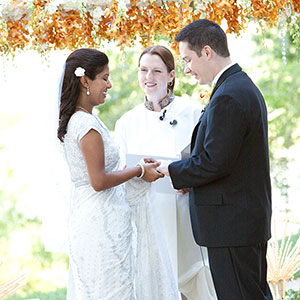
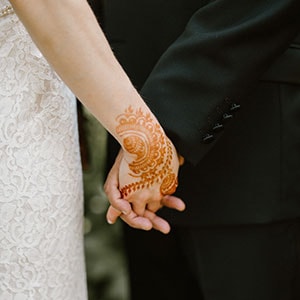
After Jessica and Nishad’s wedding ceremony, some of the guests who had been to many Hindu ceremonies (which are typically very long) complimented me on the wedding ceremony saying that it was so wonderful to see all of the traditions they were familiar with delivered in a sincere and genuine way, in much less time than a typical Hindu ceremony. One of the older gentlemen in the groom’s family even remarked, “You delivered that ceremony better than I’ve ever seen any official Hindu Priest ever do it – I hope to see you at many more Hindu wedding ceremonies!” I was so humbled by this compliment and it is exactly how I want the guests of your ceremony to feel. I want to leave them feeling that it was a true, authentic honoring of the traditions they are accustomed to without it seeming appropriated or offensive in any way.
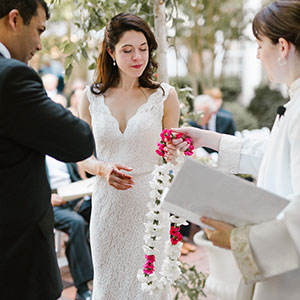
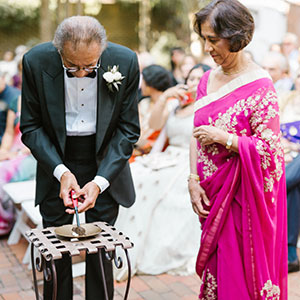
At Devin and Jeff’s ceremony, I worked closely with the couple to create a “hybrid” secular ceremony which included several elements from the Hindu tradition. It was a beautiful balance of their values as a couple and the cultural and religious traditions of Devin’s family, and came together perfectly!
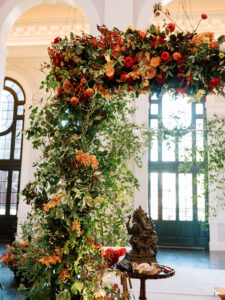


Jewish Wedding Ceremony Traditions for Interfaith Weddings
Interfaith ceremonies that include Jewish traditions can vary widely. Some couples may only want to include the tradition of the breaking of the glass, while other couples may want to be married under a Chuppah (Huppah) or Jewish wedding canopy. In either case, in an interfaith wedding the tradition of being married under a Chuppah or breaking the glass must be explained to all the guests in a way that can be easily understood for those without the background of Judaism. Some couples elect to have me explain these elements in the ceremony itself, or choose to explain the background of these traditions in the ceremony program that is given to their guests.

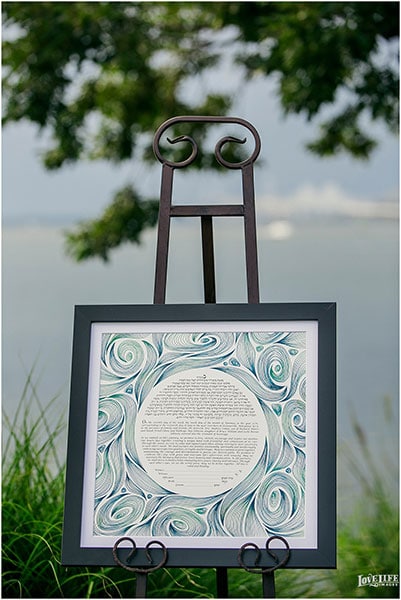
The Ketubah is a signed agreement between the couple that is also signed by witnesses, and in Jewish Tradition it is signed before the start of the public ceremony. However, for interfaith couples, it can be a wonderful ritual to include during the ceremony itself if desired. In these cases, we stand the Ketubah up on an easel up front during the ceremony. I then read the text that describes what the couple is agreeing to in English, and then invite the couple and their chosen witnesses to come forward and sign it before the couple shares their wedding vows and exchanges rings. After the ceremony, the Ketubah can then be displayed for guests to see during the cocktail hour or reception.
I get a fair number of calls from Jewish mothers who are immediately concerned when their child tells them that they have chosen me to perform their whole ceremony (instead of co-officiating with a Rabbi) and they come to my website and see those three letters in front of my name (Rev.) and immediately get worried. I explain to them that, while “Reverend” is my official title, I am an interfaith clergywoman and that they do not need to use the term “Reverend” to address me, or put it on any programs, and that I can simply sign any paperwork with my name and not use the “Rev.” in front of it. Typically, this provides a huge sigh of relief. I explain that I am going to help couple to create a ceremony that honors both religious backgrounds in an inclusive way, and that they should think of me as a professional public speaker who is reverently facilitating a ceremony that honors each of their families and traditions.
Persian-Inspired Weddings
I’ve also performed several Persian-inspired wedding ceremonies. For these ceremonies I help to facilitate a Sofreye’ Aghd (Sofreh Aghd) which roughly translates to “ceremony spread.” This is a beautiful tradition where there is a table filled with symbolic items such as a mirror and candlesticks, gold coins, sugar, flatbread, honey, flowers, nuts, rosewater, spices, fruit, holy books (in an interfaith ceremony, one from each faith) and incense. The couple is seated in front of the Sofreh Aghd and a canopy (usually a white cloth in interfaith ceremonies) is held over their heads, often by the wedding party, while married family members sprinkle sugar on the canopy above their heads adding sweetness to their marriage.

Korean and Chinese Tea Ceremonies
Tea ceremonies are popular in Asian wedding ceremonies. While Korean and Chinese weddings traditionally use tea, Japanese weddings have a similar ritual that involves sharing in sake’ (san-san-kudo). Each culture’s tea ceremony acts as a way to offer gratitude and appreciation to their elders.
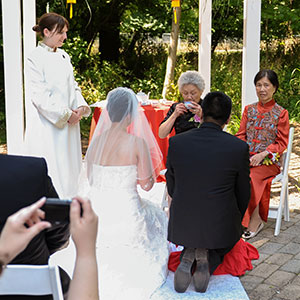

The photos below are from Alanna and Robert’s tea ceremony in which they wanted to blend Chinese, Vietnamese, and Jewish elements. In this ceremony, the bride and groom served tea to the elders in the family and the elders then each elder handed the couple a lucky red envelope (lai see) containing money or another item of value as an offering of blessings, well wishes, and good fortune for their marriage.


If you are interested in learning more about my experience creating customized interfaith and multicultural wedding ceremonies, or to check my availability for your wedding, please fill out the contact form here and mention your specific needs in the message. I look forward to hearing form you!
